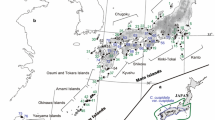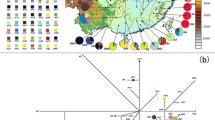Abstract
Abies nebrodensis (Lojac.) Mattei (Sicilian fir) is an endangered species represented by only one population of 29 adult individuals occurring in a limited area of the Madonie Range in northern Sicily (Italy). Taxonomic boundaries between this taxon and the neighboring Abies species are not clear. In this study, we used six chloroplast simple-sequence repeats (cpSSRs) to investigate the population genetic structure and the distribution of chloroplast haplotypic variation in A. nebrodensis and three of the neighboring Abies species: Abies alba (Mill.), Abies numidica (De Lann) and Abies cepha-lonica (Loud.). Our aims were to quantify the level of cpDNA differentiation within the Abies populations and to shed light on the history of A. nebrodensis. Diversity levels based on the haplotype frequency at six cpSSRs were high, especially in A. alba and A. cephalonica. In all, we found 122 haplotypes among the 169 individuals analyzed, and the four species were distinguished from each other by their haplotype composition. The majority of the haplotypes (76%) were detected only once, but in A. nebrodensis seven individuals (41% of the sample population) shared the same haplotype. Moreover, the seven A. nebrodensis individuals with an identical haplotype showed a tendency to be geographically grouped within the population"s limited range. The analysis of molecular variance (AMOVA) showed a significant difference in the level of apportionment of gene diversity between the species A. alba and A. cephalonica (FST=0.191 and 0.012, respectively). AMOVA analysis conducted over all populations from the four species showed that 19% of the total cpSSR variation was attributable to differences among species, 6% was due to differences among populations within species, and 74% to differences within populations. The high percentage of unique haplotypes identified confirms the power of cpSSR haplotype analysis for identifying individual trees in individual Abies populations. Our results indicate that A. nebrodensis differs from the other three Abies species investigated and support its classification as an independent taxon. The results also showed a decreased level of variation in A. nebrodensis and suggested that the species has experienced a genetic bottleneck during the last two centuries.
Similar content being viewed by others
Author information
Authors and Affiliations
Additional information
Received: 10 April 2000 / Accepted: 13 July 2000
Rights and permissions
About this article
Cite this article
Parducci, L., Szmidt, A., Madaghiele, A. et al. Genetic variation at chloroplast microsatellites (cpSSRs) in Abies nebrodensis (Lojac.) Mattei and three neighboring Abies species. Theor Appl Genet 102, 733–740 (2001). https://doi.org/10.1007/s001220051704
Issue Date:
DOI: https://doi.org/10.1007/s001220051704




